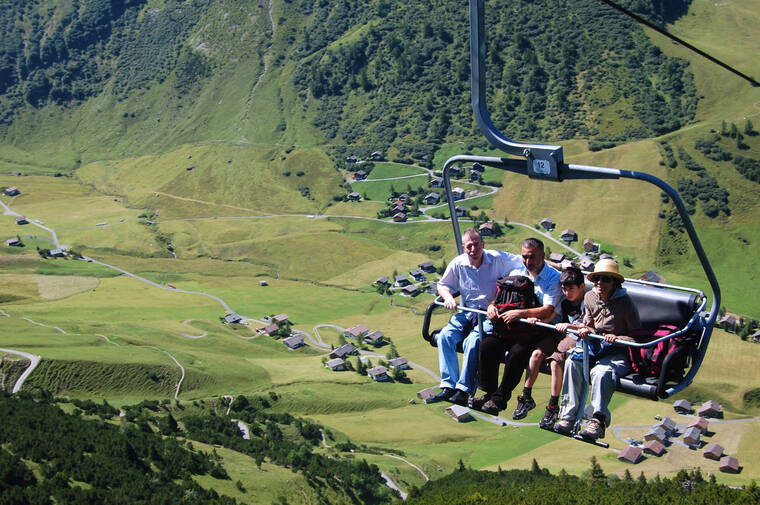Politics
Discovering the Charm and History of Tiny Liechtenstein

Liechtenstein, a diminutive but fascinating principality nestled between Switzerland and Austria, offers a unique blend of history, culture, and stunning landscapes. With a population of approximately 40,000, this landlocked nation is characterized by its remarkable geography, including the Rhine River that flows along its western border, and the impressive ridges that define its eastern limits.
The country is notable for its lack of an airport and the predominance of modern architecture in its capital, Vaduz. Visitors to Liechtenstein often find themselves among contemporary office buildings rather than quaint villages, as the nation has positioned itself as a financial hub, offering attractive tax incentives to businesses. This strategic move has attracted numerous enterprises to the principality, significantly contributing to its economy.
Royal Heritage and Economic Independence
At the heart of Liechtenstein’s identity is its royal family, particularly Prince Hans-Adam II. The prince, who has been in power since 1984, transformed his family’s bank into a global financing group long before his reign. His residence, the 13th-century Gutenberg Castle, towers majestically above the landscape, though it remains closed to the public. Visitors can, however, savor local wines in the castle’s cellar, providing a glimpse into the princely lifestyle.
Historically, Liechtenstein has undergone significant changes. In 1719, it was granted principality status by the Holy Roman Emperor, marking a pivotal moment in its evolution. The princes initially viewed the territory primarily as a status symbol and did not reside there until the 20th century. It was only in 1806, following the Napoleonic era, that Liechtenstein gained true independence, severing its ties with the Habsburg Emperor.
After the challenges posed by World War I, the principality formed an economic union with Switzerland, which continues to influence its currency and public services. The Swiss franc remains the official currency, and much of the public transportation is operated by Swiss postal buses, reinforcing the close relationship between the two nations.
Natural Beauty and Tourist Attractions
Liechtenstein is composed of 11 villages, each with its own charm. The village of Triesenberg is notable for its picturesque onion-domed church and sweeping views of the valley below. In contrast, Vaduz serves as the political and cultural heart of the country, featuring a pedestrian-friendly main street adorned with modern art and contemporary hotels.
Despite its small size, Liechtenstein boasts a rich cultural scene, which includes a national museum that chronicles the history of the princely family and the nation. Interestingly, the museum’s displays often highlight connections to Switzerland, reflecting the shared heritage and influences.
For outdoor enthusiasts, the principality’s dramatic landscapes offer numerous activities year-round. From skiing in the winter to hiking in the summer, the local terrain provides a backdrop for adventure. The longest road in Liechtenstein leads to the mountain resort of Malbun, where visitors can take ski lifts up to breathtaking heights along the Austrian border.
Tourism in Liechtenstein might not be as bustling as in its larger neighbors, but its appeal lies in its serene ambiance and unique experiences. Travelers often find it easy to explore the entire country in a single day, allowing for leisurely strolls and quiet moments to appreciate the stunning views.
On a recent visit, one could witness the sun setting over this charming principality, casting a golden hue over the landscape. Such moments encapsulate the essence of Liechtenstein, a place where history, nature, and modernity coexist harmoniously.
This article is used with the permission of Rick Steves’ Europe (www.ricksteves.com), where travel enthusiasts can find more insights into exploring the continent’s hidden gems.
-

 Science4 weeks ago
Science4 weeks agoIROS 2025 to Showcase Cutting-Edge Robotics Innovations in China
-

 Lifestyle4 weeks ago
Lifestyle4 weeks agoStone Island’s Logo Worn by Extremists Sparks Brand Dilemma
-

 Politics3 weeks ago
Politics3 weeks agoJudge Considers Dismissal of Chelsea Housing Case Citing AI Flaws
-

 World4 weeks ago
World4 weeks agoBravo Company Veterans Honored with Bronze Medals After 56 Years
-

 Health4 weeks ago
Health4 weeks agoStartup Liberate Bio Secures $31 Million for Next-Gen Therapies
-

 Science4 weeks ago
Science4 weeks agoArizona State University Transforms Programming Education Approach
-

 Health4 weeks ago
Health4 weeks agoTop Hyaluronic Acid Serums for Radiant Skin in 2025
-

 Top Stories4 weeks ago
Top Stories4 weeks agoIndonesia Suspends 27,000 Bank Accounts in Online Gambling Crackdown
-

 Sports4 weeks ago
Sports4 weeks agoMel Kiper Jr. Reveals Top 25 Prospects for 2026 NFL Draft
-

 Lifestyle4 weeks ago
Lifestyle4 weeks agoMary Morgan Jackson Crowned Little Miss National Peanut Festival 2025
-

 World4 weeks ago
World4 weeks agoHoneywell Predicts Record Demand for Business Jets Over Next Decade
-

 Sports4 weeks ago
Sports4 weeks agoYamamoto’s Mastery Leads Dodgers to 5-1 Victory in NLCS Game 2









